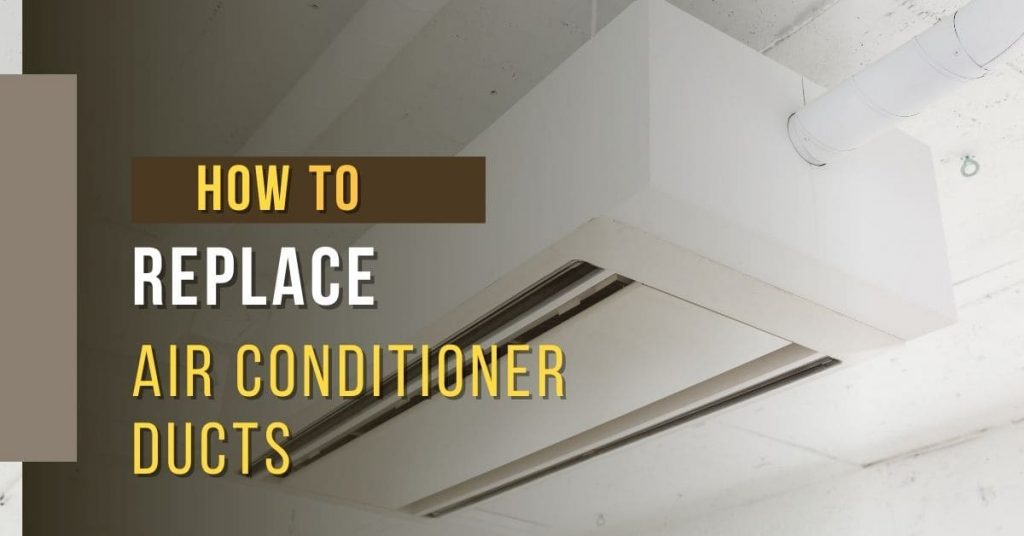Are you questioning how to replace air conditioner ducts? And you discover it obscure this subject of air conditioner ducts.
We’re going to clarify about this subject and also you’re going to know when you may replace air conditioner ducts as a result of ducts aren’t changing till see indicators point out that your air conditioner ducts want to exchange and alter, furthermore we’re going to clarify about ducts tips on how to measurement and design ducts and extra info and directions about air conditioner ducts.

Signs indicate that your air conditioner ducts need to replace
- Tears and holes are seen within the uncovered areas
- Water leaks are current in some areas of your private home
- Your ductwork has been put in for over 9 to 16 years
- Airflow in several elements of your private home is irregular
- Different rooms in your house present diversified temperatures
- Uneven Heating or Cooling
- Having A Dusty Home
- Having A Problem with Pests
- Seeing Debris Around The Vents.
- High Energy Bills
- Smelling Mold and Mildew in Your House.
- Noisy HVAC Operation.
- Having Respiratory Problems.
It is essential to have clear and well-insulated ductwork. If it’s worn out and it’s not attainable to restore, then it wants a substitute. It is healthier to have duct repairs or replacements than have greater vitality payments.
If there may be air leakage, the HVAC system will work more durable, thus utilizing up extra vitality and put on in your system than vital.
How to replace air conditioner ducts?
Many owners are reluctant to have duct repairs or changes attributable to the price of this sort of service.
If you’ve got a tough time making a choice, call the consultants at Heating & Air Conditioning. Or a qualified person & professional
They will ship a technician to your private home to evaluate the situation of your ductwork. Whether it may nonetheless be repaired or wants substitute, believe them to provide the best quote for the job.
purchasers like households so they’re all the time able to offer you suitable choices and suggestions to make sure that you’ll have an environment-friendly HVAC system.
How to size and design ducts?
Airflow issues have plagued the HVAC business for years. No matter how a lot of cash you spend on a high-quality HVAC system, the gear received works at its finest without being correctly designed and put in ductwork.
Ducts that aren’t well-designed end in discomfort, excessive power prices, unhealthy air high quality, and elevated noise ranges.
A well-designed ductwork system ought to ship most inside consolation on the lowest working price while additionally preserving indoor air high quality. The chief necessities of an air conduct system are:
1. It ought to convey specified charges of airflow to prescribed areas.
2. It must be economical in mixed preliminary price, fan working price, and value of constructing a house.
3. It mustn’t transmit or generate objectionable noise.
A major concern is a tradeoff between the preliminary price of the duct system and the power price of the air distribution system. Larger ducts require bigger preliminary funding however end at decreased fan power prices over the lifetime of the system.
Other points embrace house restrictions, noise stage, capability for growth, look, and so forth. This course will talk about the basics and rules of air conduct design and format.
DUCTWORK DESIGN PRINCIPLES
Starting with the fundamentals, let’s begin on the most basic stage of airflow fundamentals
Basic Definitions :
The following primary terminology is extensively used in this course.
• cfm: quantity of air circulate; cubic ft/minute
• fpm: velocity or velocity of air circulate; ft/minute
• sq.ft: duct measurement or cross-sectional space; sq. ft
Air quantity in cfm might be calculated by multiplying the air velocity by the cross-sectional space of the duct in sq. ft
• cfm = fpm x Area
Given any two of those three portions, the third might be readily decided:
• fpm = Cfm/space
• Area = Cfm/fpm
Note: Please remember these definitions we’ll use below as a short meaning
What is duct sizing for air conditioner?
The most generally used technique to measurement ducting is the equal friction technique. The different strategies are velocity discount and static regain.
Method1
Equal friction technique:
The Equal Friction design technique sizes the ducts for a relentless “Friction Rate”, which describes the typical strain drop per 100 ft of duct in a system.
quite common friction charge for a fairly well-designed system is 0.1 in.-WC per 100 ft. of duct size. Reduced friction charges of 0.05 in.-WC per 100 ft.
will increase the duct measurement and prices by 15%, however, cuts the portion of the entire strain drop in ductwork by 50%, leading to a power financial savings of 15% to 20%.
Procedure:
The equal friction technique makes use of a duct slide rule, duct calculator, or friction charge chart to find out the connection between duct measurement and airflow, i.e. how a lot of air will come out of a given measurement duct. The methodology is as follows:
1. Select the most air velocity in the principle duct after the fan outlet.
2. Enter the friction chart realizing the cfm and velocity to find out the friction charge per 100 ft of duct size and choose the diameter.
3. From the friction charge obtained within the earlier step, use the identical worth to find out diameters for all different sections of the ductwork.
4. The complete friction loss within the duct system is then calculated by multiplying the friction loss per 100-foot of size to the equal size of probably the most important path of the ductwork having the most resistance.
Example:
Determine the diameter and the speed of air via a duct carrying 1,000 cfm of air. Assume a friction lack of 0.1 in.-WC per 100 ft. of duct size. Determine the actual strain drop and velocity on the chosen duct measurement.
Solution:
From the above monograph, the 0.1 in.-WC per 100 ft.
friction line intersects the 1,000 cfm line at around duct diameter of 13.5 inches.
Select the following out there spherical duct measurement of 14”.
When this duct is used, the strain loss will likely be 0.09 in.- WC/100’, and the speed is ~800 fpm.
There are a wide range of commercially out there duct calculator instruments (also called dictator) that might be simple and correct to make use of for sizing ducts if you recognize the circulate charge and friction loss or velocity. Use the next friction loss pointers for sizing ducts with a duct calculator instrument.
| System Type | Friction Loss per 100 Feet of Duct (inch water column) |
| Supply run-outs | 0.08 |
| Supply trunk or plenum | 0.05 |
| Return ducts | 0.02 |
Advantages of the Equal Friction Method:
1. The technique is simple.
2. It routinely reduces air velocities within the route of airflow, which in flip reduces the potential airflow-generated noise.
3. It is probably the most acceptable technique for fixed air quantity (CAV) programs.
Limitations of the Equal Friction Method:
1. There is not any equalization of stress drops in duct branches except the system has a symmetrical format. Balancing dampers have to be put into the steadiness of the system.
2. It isn’t beneficial for VAV programs. If used for VAV provide duct design, the terminal models require pressure-independent (Pi) management functionality to keep away from extreme circulation charges when duct stress is excessive.
3. It isn’t versatile and adaptable to future format modifications.
WHAT ARE AIR CONDITIONER DUCT COMPONENTS AND MATERIALS?
The air distribution system may have a designation relying on the performance of the duct.
Broadly, there are 5 designations of ducts:
1. Supply air ductwork provides conditioned air from the air dealing with the unit to the conditioned space.
2. Return air ductwork removes air from the conditioned constructing areas and returns the air to the air dealing with the unit, which reconditions the air. In some instances, a part of the return air on this ductwork is exhausted to the constructing exterior.
3. Fresh air ductwork provides doors air to the air dealing with the unit. Outdoor air is used for ventilating the occupied constructing area.
4. Exhaust (reduction) air ductwork carries and discharges air to the outside. Exhaust air is taken from bogs, kitchens, laboratories, and different areas requiring airflow.
5. Mixed air ductwork mixes air from the doors air and the return air then provides this blended air to the air dealing with the unit.
Duct Materials :
Ducting is mostly shaped by folding sheet steel into the specified form. Traditionally, air-con ductwork is the product of galvanized metal, subsequent in recognition is aluminum. Other metals used beneath particular circumstances are copper and stainless steel.
Metals that are used extensively depend upon the appliance of the duct and are listed beneath:
1. Galvanized Steel: It is a typical, most typical material utilized in fabricating ductwork for many comfy air-con programs.
2. Aluminium: It is broadly utilized for cleanroom purposes. These are additionally the most well-liked programs for moisture-laden air, particular exhaust programs, and decorative duct programs.
3. Stainless Steel: It is utilized in duct programs for kitchen exhaust, moisture-laden air, and fume exhaust. The specs for chrome steel sheet are ASTM A167, Class 302 or 304, Condition A (annealed) Finish No. Four for uncovered ducts, and Finish No. 2B for hid duct.
4. Carbon Steel (Black Iron): It is broadly utilized in purposes involving flues, stacks, hoods, different excessive temperatures, and particular coating necessities for industrial use.
5. Copper: It is principally used for sure chemical exhaust and decorative ductwork.
Pressure within the air conducts is small, so supplies with quite a lot of power usually are not wanted. The thickness of the fabric is dependent upon the size of the duct, the size of the person sections, and the cross-sectional space of the duct.
Non-Metallic ducts
This class contains ducts comprised of plastic or foam boards, formed by reducing and folded to supply the required cross-sectional geometry.
Boards are confronted often with an aluminum coating, each inside, and exterior.
The predominant disadvantage of the sort of ducting is its fireplace classification.
Even if it complies with native requirements, when uncovered to the fireplace, it usually reveals poor efficiency when it comes to the manufacturing of each smoke and flaming droplet.
1. Fibreglass Reinforced Plastic (FRP): It is used primarily for chemical exhaust, scrubbers, and underground duct techniques.
Advantages are resistance to corrosion, self-insulation, glorious sound attenuation, and high-quality sealing.
Limiting traits embrace price, weight, vary of chemical and bodily properties, and code acceptance.
2. Polyvinyl Chloride (PVC): It is used for exhaust techniques for chemical fumes and underground duct techniques.
Advantages embrace resistance to corrosion, lightweight, and ease of modification. Limiting traits embrace price, fabrication, code acceptance, thermal shock, and weight.
3. Fabric: Fabric ducting, often known as textile ducts, is often the product of particular permeable polyester materials and is often used the place even air distribution is important. Due to the character of the air distribution, textile ducts usually do not often hide inside false ceilings.
Condensation will not be a priority with material ducts and subsequently, these can be utilized the place the air is to be provided under the dew level without insulation.
4. Flex Duct: Flex ducts include a duct inside liner supported on the within by a helix wire coil and coated by blanket insulation with a versatile vapor barrier jacket on the surface.
Flex ducts are sometimes used for runouts, in addition to steel collars used to attach the versatile ducts to provide plenums, trunks, and branches constructed from sheet steel or duct board.
Flex ducts present the comfort of set up as these might be simply tailored to 14 keep away from clashes however have sure disadvantages.
These have extra friction loss inside them than steel ducting. Flex duct runs must be as brief as doable (5 to six ft. max.) and must be stretched as tight as doable.
Duct Components
The determine beneath exhibits a schematic and a 3-D illustration of providing and returning air ductwork.
The central air dealing with the unit (AHU) is related to the air plenum at the start line. AHU followers attract air by way of grilles referred to as returns and power air by way of the plenum and into the conditioned house by way of providing registers.
The duct elements are as follows:
1. Plenum or Main Trunk: The plenum is the principle a part of the availability and returns duct system that goes immediately from the air handler to the “Trunk Duct”.
2. Trunk Duct: A duct that’s broken up into a couple of ducts is named a “trunk”, identical to a tree. Ducts that are on the tip of a trunk and terminate in a register are referred to as branches.
3. Take-Off: Branch ducts are mounted to the principal trunk by a takeoff becoming. The takeoff encourages the air transferring the duct to enter the takeoff to the department duct.
4. Air Terminals Devices: Air terminals are the available air shops and return or exhaust air inlets. For provide, diffusers are commonest, however, grilles and registers are additionally used broadly.
A diffuser is an outlet machine discharging provide air in a course radially to the axis of entry. A register is a grille outfitted with a quantity management damper. A grille is not using a damper.
Read also:
- How to install air conditioner condenser?
- How to remove air conditioner?
- Air conditioner capacitor what does it do?
- What is a split system air conditioner?
- What is an air handler on an air conditioner?
- How to install a wall air conditioner?
- The ultimate guide to air conditioner troubleshooting
- How to clean air conditioner?
After reading all instructions above you may have a general overview of how to replace air conditioner ducts?






